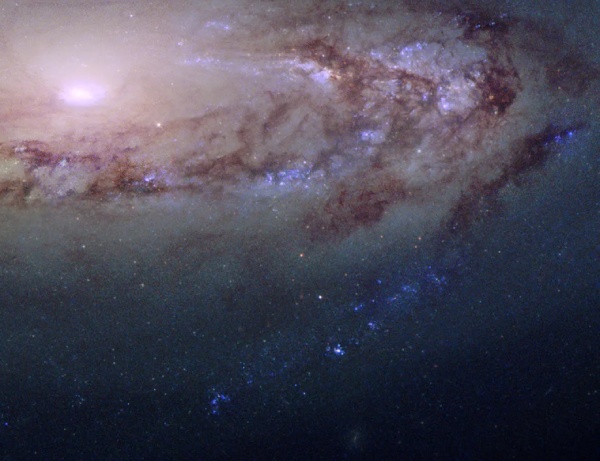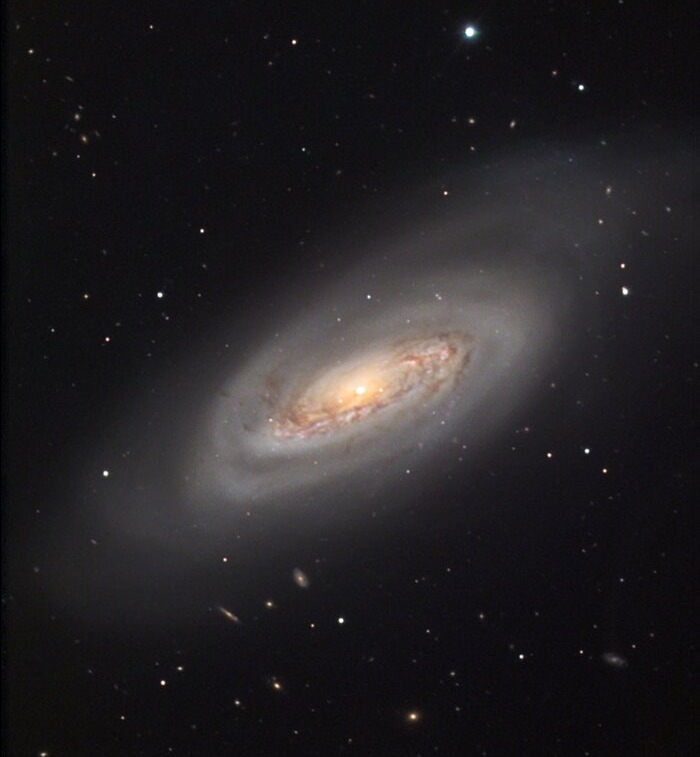The M90 spiral galaxy, also known as NGC 4569, is a prominent member of the Virgo Cluster, located approximately 60 million light-years away in the constellation Virgo. Discovered by Charles Messier in 1781, M90 is a barred spiral galaxy, characterized by its elongated central bar structure and sweeping spiral arms. With an apparent magnitude of 9.5, it is one of the brighter spiral galaxies in the Virgo Cluster, making it observable with moderate-sized telescopes. M90 spans about 107,000 light-years in diameter, slightly larger than the Milky Way.
Structure and Features
One of the key aspects of M90 is its high blue shift, which indicates that it is moving towards us at a speed of about 383 kilometers per second. This is unusual because most galaxies in the universe are moving away from us, showing a redshift due to the expansion of the universe. The blue shift in M90’s case is a result of its complex motion within the Virgo Cluster, influenced by the gravitational interactions with other cluster members and the cluster’s overall gravitational potential.

The galaxy’s morphology is classified as SAB(rs)ab, indicating that it has a weakly barred structure (SAB), a somewhat ring-like feature (rs), and moderately tightly wound spiral arms (ab). The central bar of M90 is prominent, and the spiral arms are adorned with numerous star-forming regions. However, compared to other spiral galaxies, the galaxy has a relatively low star formation rate. This is largely due to the ram-pressure stripping effect, where the galaxy’s gas is being stripped away as it moves through the hot, dense intracluster medium of the Virgo Cluster. This process removes the raw material needed for star formation, leading to the observed reduction in new stars being formed.
Interactions with other galaxies
Additionally, M90 exhibits signs of past interactions with other galaxies. These interactions have likely contributed to the stripping of gas and the disturbed appearance of its outer regions. Ultraviolet observations from the GALEX satellite have shown that while the inner regions of M90 are relatively star-forming deficient, the outer regions still contain some young star clusters, suggesting that the stripping process has been more effective in the galaxy’s core.
Infrared observations reveal the presence of dust within M90, which aligns with regions of ongoing star formation. The Spitzer Space Telescope has detected significant amounts of polycyclic aromatic hydrocarbons (PAHs), complex organic molecules found in the dust clouds, which are often associated with star-forming regions.
Observations in various wavelengths, from radio to X-ray, have provided insights into the galaxy’s structure, stellar populations, and the effects of its interactions within the Virgo Cluster.
In summary, M90 is a dynamic and complex galaxy whose study provides valuable insights into the effects of cluster environments on galaxy evolution. Its interactions within the Virgo Cluster, combined with the processes of ram-pressure stripping and past galactic encounters, make it an important object for understanding the intricate life cycle of spiral galaxies in dense clusters.
Observation
M90 is best observed from spring to early summer in the Northern Hemisphere. During this period, Virgo rises in the eastern sky in the evening and reaches its highest point in the sky around midnight in April and May.
M90 can also be seen from the Southern Hemisphere, but its visibility is limited. The farther south you are, the lower Virgo will appear in the northern sky. Observers closer to the equator will have a better view compared to those at higher southern latitudes. However, the galaxy will not reach a high altitude and will be closer to the horizon, making it more challenging to observe due to atmospheric distortion and light pollution.

With an apparent magnitude of 9.5, M90 is too faint to be seen with the naked eye or even with most binoculars. Observing the galaxy requires at least a small to medium-sized telescope (4 to 8 inches in aperature). In small telescopes, the galaxy can be spotted as a faint, diffuse object. Medium sized instruments (8 to 10 inches) will allow you to see its elongated shape and possibly some structure in the central bar and spiral arms under good conditions. With larger telescopes (12 inches) you can see more details, including the spiral arms and brighter star-forming regions, especially if observing from a location with minimal light pollution.



